During a Senate hearing on Friday (10 October), Bullock said she expects the private sector to take over from the public sector as a driver of economic growth, reiterating her comment from the most recent Monetary Board Statement.
“What we’re starting to see now is a bit of a switch between the public and the private sector,” she said.
The Reserve Bank of Australia (RBA) governor attributed the shift to the combination of reduced public demand, strong unemployment rates, and inflation stabilising at target levels fuelling stronger consumption.
Looking back at the last few years, Bullock explained that household consumption had been “very weak” for some time due to declining real incomes, low consumer confidence and increasing interest rates.
“People weren’t feeling confident,” she said. “Interestingly, people had jobs, but interest rates were rising and it had remained high, so all of these sorts of things were playing into that.”
During that period, she said public demand was essentially “filling that gap” to compensate for the shortfall in consumption and investment.
While Liberal senator James Paterson argued that public demand was contributing to the need for increased interest rates over that period, Bullock asserted that the government needed to spend during COVID-19 to support the economy.
“They’ve got to balance all these different demands on their purse,” Bullock said.
The senator further referenced remarks made by former RBA governor Philip Lowe (reported by The Australian Financial Review in August) which suggested that the Albanese government’s spending was hindering the central bank’s efforts to combat inflation.
Bullock did not provide a comment, stating that Low is “free to say what he likes”.
She noted that while one could speculate on the inflationary outcome had public sector demand not stepped up at the time, much lower employment was a distinct possibility.
“We’re in a pretty good spot,” Bullock said.
Her stance was informed in part by June quarter gross domestic product (GDP) results, which found that household consumption rose by 0.9 per cent, while government consumption increased by 1 per cent.
Consumption had been expected to increase due to rising wealth and falling interest rates, but Bullock said it grew “stronger than expected” over the period.
While Paterson highlighted that government spending was still higher, RBA assistant governor Christopher Kent countered that household consumption contributed a much smaller share of the economy.
“The contribution to GDP growth, particularly over the year for government [spending], has definitely come down and private [has] come up,” Kent said.
Meanwhile, Bullock also downplayed Senator Paterson’s comments that business and private investment growth has been insufficient, highlighting the strength of certain sectors including software and data centres.
The senator further challenged Bullock’s claim regarding the private sector, contending that public spending continued to outpace real economic growth in the previous financial year.
Bullock doubled down, concluding that while she can’t comment on changes in public demand in future, private contributions are telling the story.
“And with our current forecast, with their [Treasury’s] current forecast, we continue to see private demand picking up over the next year and starting to take over from public [demand].”






